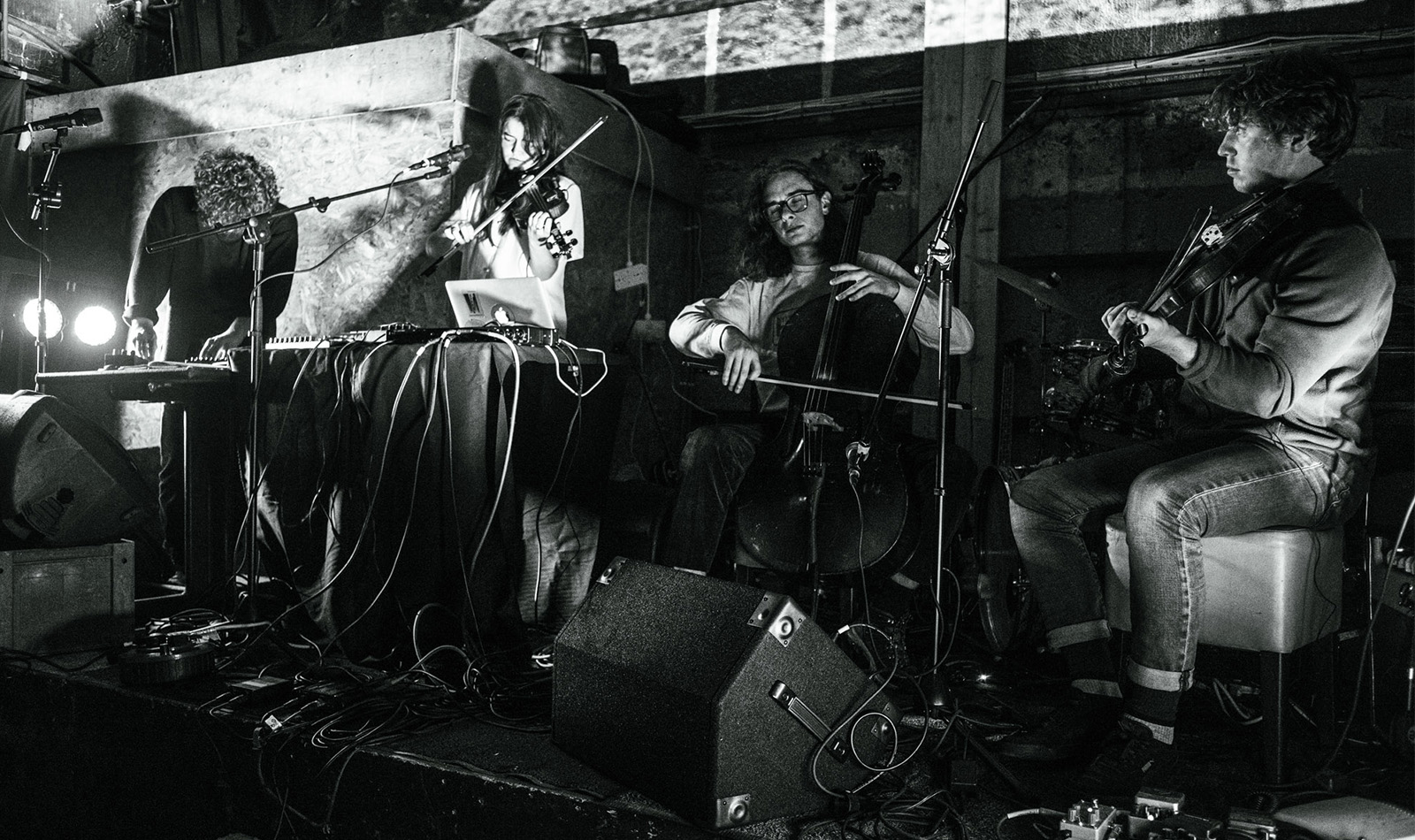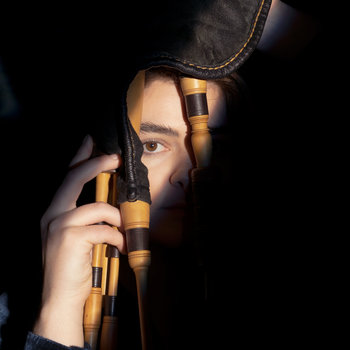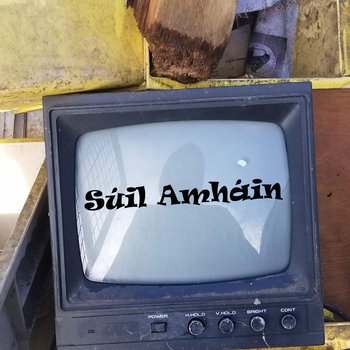Gliogar Platform “Weirdo Ceol” Across Ireland (original) (raw)
SCENE REPORT Gliogar Platform “Weirdo Ceol” Across Ireland By Julie Landers · October 11, 2024 
Based on Gliogar’s commitment to furthering the Irish language, we are making this piece available in both Irish and English. The Irish translation by Seán Ó Cuireáin is here.
Gliogar: A word which, when translated from Irish, names a rattling sound, the tinkling of bells. It evokes an image of objects colliding, and their resonances hanging in the air—catching, unmistakeable. It is an apt name for what artists Peadar Tom (PT) Mercier, Rísteárd Ó hAodha, and Aindriú de Buitléir have found themselves doing—bringing their own unique angle to the cultural and sonic landscape of Ireland. In a short space of time, the trio have established Gliogar as an exciting entity in the promotion of Irish language and culture through the booking of live shows throughout the country.
Gliogar began in 2022, after Mercier had moved back to An Cheathrú Rua, a village in Connemara in the west of Ireland, after several years of living in Cork city in the south. Despite no longer living in the city, “Feargal MacGabhann (proprietor of the Corner House, a beloved pub and meeting place for musicians in Cork) asked me if I would put on my own gigs there,” Mercier remembers.
He accepted the job and started booking eccentric and exciting lineups in the small pub. Meanwhile, Ó’hAodha and de Buitléir had also moved to An Cheathrú Rua—Risteárd was working as a coordinator for TradTG4, the music-focused offshoot of the Irish language broadcaster TG4, and de Buitléir was working locally as a sound engineer for Irish-language summer school Coláiste Lurgan and Irish-language soap Ros na Rún. The trio’s respective interests in the Irish language, DIY gigs, and showcasing “weirdo _ceol_” brought them together as collaborators.
Under the name Gliogar, they started putting on shows in Limerick, Galway, and Dublin. However, an interest in and intention to put on shows closer to home, in the Gaeltacht areas (areas where the primary language spoken is Irish) of Connemara, was always at the front of their minds. “There are plenty of spaces and platforms [in Connemara] for traditional music. There isn’t a lack of music being made here. But we wanted to give a platform to the stranger stuff,” explains Mercier. “When we’re programming, we’re looking at artists who are working through Irish, or with the Irish language, and in Gaeltacht communities and trying to give them a platform for their own music,” Ó hAodha adds.
The trio have received financial support from local Oifigigh Pleanáil Teanga (OPTs), language planning officers working with funding bodies Údarás and Ealaín Na Gaeltachta, whose aim is to preserve and encourage the use of the Irish language in business and cultural contexts. This has made it possible for Gliogar to host shows for small audiences in remote, sparsely populated Gaeltacht areas—for example, booking Scottish piper Brìghde Chaimbeul and accordionist Seamas Hyland to play in Indreabhán, a Gaeltacht village west of Galway city—without asking the artist to bear the financial burden. Hosts on RTÉ Raidio na Gaeltachta, the Irish-language branch of the national broadcaster, have also been supporters of Gliogar, frequently platforming their work and events. (“Shoutout to Micheál Ó Tuathail!” enthuses Mercier.)
Indeed, it is Raidió na Gaeltachta that is home to one of the longest running and most eclectic shows on the radio today: Cian Ó Ciobháin’s An Taobh Tuathail. Ó Ciobháin has been highlighting avant-garde and experimental music both from Ireland and abroad for 25 years, all in Irish. There is a legacy for “weirdo _ceol_” both in the Gaeltacht and in the wider Irish speaking community–Giordaí Ua Laoghaire, Seán Monaghan, and the Maimín Cajun Band are just some of the names that come to mind when thinking about the tradition of rupturing the traditional. “We want to show that people living in these places are capable of doing things like this,” explains de Buitléir.
Below are some of the artists who have worked with and been hosted by Gliogar, each working through Irish and Gaidhlig as they traverse genre, time, and instrument to offer new ways of hearing the temporalities and tongues they are working through.

Trá Pháidín
Led by Mercier, Trá Pháidín have made a name for themselves in recent years with their ability to blend styles including trad, krautrock, free jazz, and ambient to create something singular and exciting. The nine-piece bring their respective influences together in bright live performances with a sense of humor that does not diminish their propensity for reflection. An 424 takes the listener on the bus route that leads from rural Conamara through to Galway city. The bumps in the road, the sharp bends, the transition from pastoral to pavemented: all are communicated via the group’s expert control of texture and timing.
Seamas Hyland
Hyland’s distinctive accordion and melodeon playing can be heard in his work with The Mary Wallopers, John Francis Flynn, Isadora Epstein, and Eimear Walshe, to name a few. On his debut solo LP, Maidin Domhnaigh, the Waterford multi-hyphenate moves closer to the spotlight with contemplations on traditional playing that do not feel suffocated by ideas of purity that are too often mistaken for integrity. Hyland moves across humors and tempos with a wonderful fluidity. Opening track “Navan Road” sets a mischievous tone for the rest of the album, whilst “Press and Draw” offers a moment of deep listening to the apparatus of the accordion itself, as clicking keys and shuddering bellows punctuate the pensive melody. With a textured mix of old and new compositions, field recordings, and percussive elements provided by the enigmatic Ross Chaney, Maidin Domhnaigh is a standout Irish release of the year, offering musings on what an instrument and its heritage can mean.
RÓIS
Depending on who you talk to, those who have seen Fermanagh musician Rose Connolly aka Róis perform live have seen very different versions of her. Her work spans across ensemble work, solo electronic improvisation, traditional music and contemporary jazz, to name a few. Yet across each iteration, her singular style and voice stands out. Uisce agus Bean is a compelling introduction to Róis and her versatility. She deploys dissonance like a veteran in the art of haunting, introducing a sinister skein within the most luscious of tracks. Her latest release, MO LÉAN, offers a reimagining of the Irish song tradition of keening—a raw and powerful lamenting which captures the immensity of a grief. Róis weaves spoken word and ethereal cries over trip-hop beats and moments of hyperpop effervescence to conjure up a dynamic reinterpretation of tradition that asks us to consider what it means to live within and alongside death.
Princ€ss
Ireland’s underground supergroup have shrouded themselves in anonymity, yet their facelessness does not imply an absence of identity. On last year’s self-titled LP, Princ€ss embraced nebulousness in swirls of glitching, expansive noise. The songs unfold like images in a dream—coherency lies on the periphery, just beyond our grasp. At times the tracks shimmer and groan, and a central feeling is never fully identified or made tangible. This is not a complaint. Rather, Princ€ss are part of a lineage of artists who make the listener question their normal listening patterns and challenge them to sit in a sound that is both uncanny and textured.
Brìghde Chaimbeul
Isle of Skye smallpiper Chaimbeul has brought the instrument to new audiences in recent years, with a solo on Caroline Polachek’s “Blood and Butter” offering a captivating synth-y exploration into what a bellows-blown instrument could—or should—be. Hers is a sound that carries as much weight in a packed-out 18th Century church in The Hague for the Rewire festival as it does in the Seanscoil Sailearna in Indreabhán. Her 2023 LP Carry Them With Us finds her collaborating with reedist Colin Stetson across 10 tracks that bring the listener close to the heart of the drone, a sonic device of either annihilation or evocation, depending on the benevolence of the artist.
Muireann ní Shé
 . 00:10 / 00:58
. 00:10 / 00:58
This Cork multi-instrumentalist is another artist who comes to mind when considering the ways that the contemporary and the traditional can not only co-exist, but can be brought together to create a vibrant soundscape. Ó’She’s debut album Éistigh Liomsa Sealad showcases her proficiency as an uilleann piper, and positions her as a formidable candidate to carry the mantle of the instrument’s rich history. Coupled with sean nós arrangements accentuated by her crystalline voice and thoughtful ornamentation, this is a work that expertly demonstrates Ní Shé’s capabilities as a musician, arranger, and torchbearer.
Súil Amháin
The Listowel rapper’s off-kilter flow has positioned him amongst the heavy hitters in a new generation of rappers working in the Irish language. His tracks offer a collaged sense of time and Irish identity through incisive sampling and layered lyricism. His debut album athPhORT sees him in peak form, his flow swaggering and his words displaying both reflection and ambition. Produced by Bantum, athPhORT is a landscape of 808 beats, found sounds and off-kilter rhythms in which Súil Amháin reminds us with humor and grit that his is one of the most distinctive voices on the island right now.
Colm Seoighe agus na hEasógaí
One name that emerges throughout the conversation with the Gliogar crew as a definition of the kind of oddball, exciting art they are trying to platform is Colm Seoighe agus na hEasógaí. The young band from Connemara are putting their own spin on the songs they grew up with, injecting them with an effervescence that would captivate an audience in any language. Driving bass and banjo provide their take on the normally serene sean nós tune “Pota Mór Fataí” with a boisterous propulsion that makes it simply great fun to listen to. Their enthusiasm rings out like a bell across their discography and theirs is a name to keep an eye out for.







